
Butterflies are winged insects from the lepidopteran suborder Rhopalocera, characterized by large, often brightly coloured wings that often fold together when at rest, and a conspicuous, fluttering flight. The group comprises the superfamilies Hedyloidea and Papilionoidea. The oldest butterfly fossils have been dated to the Paleocene, about 56 million years ago, though they may have originated earlier.

Lepidoptera or lepidopterans is an order of winged insects that includes butterflies and moths. About 180,000 species of the Lepidoptera have been described, representing 10% of the total described species of living organisms, making it the second largest insect order with 126 families and 46 superfamilies. and one of the most widespread and widely recognizable insect orders in the world.

Moths are a group of insects that includes all members of the order Lepidoptera that are not butterflies. They were previously classified as suborder Heterocera, but the group is paraphyletic with respect to butterflies and neither subordinate taxon is used in modern classifications. Moths make up the vast majority of the order. There are approximately 160,000 species of moth, many of which have yet to be described. Most species of moth are nocturnal, although there are also crepuscular and diurnal species.
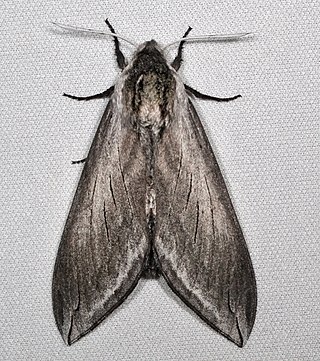
Sphinx perelegans, commonly known as the elegant sphinx, is a species of hawkmoth described by Henry Edwards in 1874. It is a large gray moth native to western North America.

Hemaris thetis, the Rocky Mountain clearwing or California clearwing, is a moth of the family Sphingidae. The species was first described by Jean Baptiste Boisduval in 1855. It is found from Colorado, New Mexico, Montana, Idaho, Wyoming and Utah west to California and north to British Columbia. The habitat consists of streamsides and meadows in mountainous areas.

Catocala meskei, or Meske's underwing, is a moth of the family Erebidae. The species was first described by Augustus Radcliffe Grote in 1873. It is found in North America from Maine and Quebec west to southern Alberta and Montana, south to South Carolina in the east and at least Montana in the west.

Actebia fennica, the black army cutworm or Eversmann's rustic, is a moth of the family Noctuidae. The species was first described by August Michael Tauscher in 1806. It has a Holarctic distribution from Newfoundland through western Europe, Siberia, the Far East, Mongolia, northern China to Korea and Japan. In North America it is mainly found in the boreal region, south to New England, southern Montana and northern Oregon.

Syssphinx bicolor, the honey locust moth, is a North American moth in the family Saturniidae.

Rachiplusia ou, commonly known as the gray looper moth, is a species of moth in the family Noctuidae. The species was first described by Achille Guenée in 1852. It is found in the southern and eastern parts of the United States, Montana, Nova Scotia, from Mexico to Venezuela to Ecuador and the Dominican Republic.
Coenophila opacifrons, the blueberry dart or plain-faced blueberry dart, is a moth of the family Noctuidae. The species was first described by Augustus Radcliffe Grote in 1878. It is found in North America from Labrador and Newfoundland, south to New Jersey, west across the boreal forest to eastern British Columbia, south in the mountains to southern Montana.
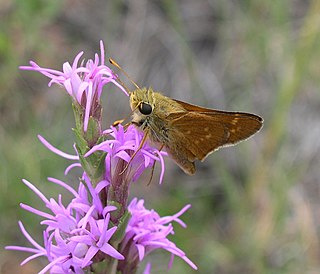
Hesperia leonardus, the Leonard's skipper, is a butterfly of the family Hesperiidae. There are three subspecies. Next to the nominate species, these are the Pawnee skipper, which is found in North America from western Montana and south-eastern Saskatchewan east to Minnesota, south to central Colorado and Kansas. Leonard's skipper ranges from Nova Scotia and Maine west through southern Ontario and the Great Lakes region to Minnesota, south to North Carolina, Louisiana and Missouri and the Pawnee montane skipper is endemic to the South Platte River drainage of Colorado.

Hyalophora columbia, the Columbia silkmoth or larch silkmoth, is a moth of the family Saturniidae. In the east it is found from Quebec and Ontario to Michigan, northern Wisconsin, and south-eastern Manitoba. In the west it is found from Alberta and Montana south through the Rocky Mountains to south-western Texas and into central Mexico. The species was first described by Sidney Irving Smith in 1865.

Neogurelca montana, the narrow-banded hawkmoth, is a moth of the family Sphingidae. It is known from central and south-western China.

Hellinsia paleaceus is a moth of the family Pterophoridae described by Philipp Christoph Zeller in 1873. It is found in North America, including Florida, Mississippi Maryland, Montana, Texas, California, Nebraska, New Mexico and south-eastern Canada. It has also been recorded from Puerto Rico.

Orgyia pseudotsugata, the Douglas-fir tussock moth, is a moth of the subfamily Lymantriinae first described by James Halliday McDunnough in 1921. It is found in western North America. Its population periodically irrupts in cyclical outbreaks. The caterpillars feed on the needles of Douglas fir, true fir, and spruce in summer, and moths are on the wing from July or August to November.
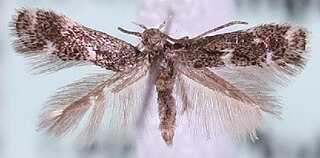
Elachista tetragonella is a moth of the family Elachistidae. It is found from Fennoscandia to Spain and Italy and from France to Bulgaria.
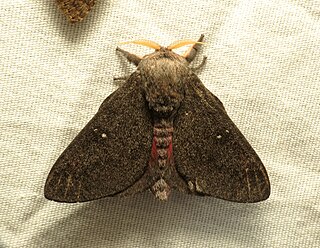
Syssphinx hubbardi, or Hubbard's silk moth, is a species of moth in the family Saturniidae. It is found in Mexico and the southern United States.
Apantesis doris, the Doris tiger moth, is a moth of the family Erebidae. It was described by Jean Baptiste Boisduval in 1869. It is found in North America from British Columbia, northern Idaho, Alberta and western Montana. In the east, it is found in the Atlantic Coast provinces and from Nova Scotia to northern Florida and west to central Texas. The habitat consists of open willow/sedge fens and probably other open wetlands in the boreal forest.
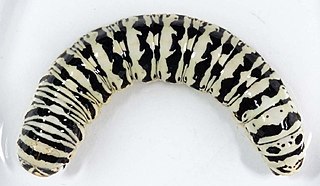
Cucullia speyeri, common names Speyer's paint, Speyer's cucullia or Speyer's hooded owlet moth, is a moth found in North America. It is found from Alberta and Montana to the Atlantic coast from New Hampshire to Virginia. It was described by Joseph Albert Lintner in 1874. In the US state of Connecticut, it is listed as a species of special concern and is believed to be extirpated. The habitat consists of open meadows, dry grasslands and native prairies.
Syssphinx albolineata is a species of giant silkworm moth in the family Saturniidae. It is found in Central America and North America.
















